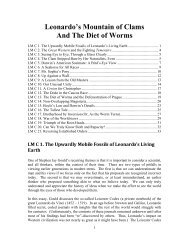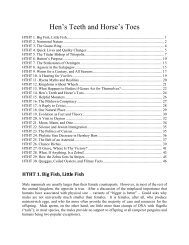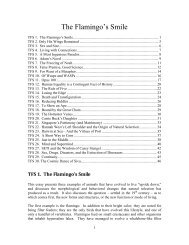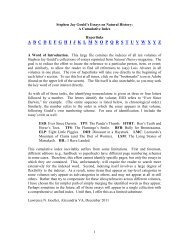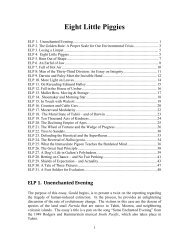counterproductive (due to their speculative and untestable assumptions). Gradualprocesses – to include the occasional earthquake, volcano, and flood, at the levelsobserved in historic times – should be exclusively assumed, he argued. The communityshould cease further theorizing, and instead concentrate on characterizing, dating, andmatching up the earth’s strata (a huge and vitally important undertaking, to be sure).Darwin strongly agreed with Lyell’s gradualist view of both geology and paleontology,but differed with regard to the philosophical perspective of pure observation with noconceptual, theoretical framework in mind. Gould’s office door displayed his “bumpersticker” view of the relationship of theory and observation, taken from the last sentenceof the following paragraph that Darwin wrote to Henry Fawcett in a letter from 1861:<strong>About</strong> thirty years ago there was much talk that geologists ought only to observeand not theorize; and I well remember someone saying that at this rate a manmight as well go into a gravel-pit and count the pebbles and describe the colors.How odd it is that anyone should not see that all observation must be for oragainst some view if it is to be of any service!<strong>In</strong> this passage, Darwin argues that it is essential to possess some sort of theoreticalframework if one is to organize and “make sense of” the observations one makes. Gouldextends this by claiming that it is impossible for humans not to hold or form at least atentative model while studying a subject. However, he adds, these models can also limitwhat we observe, constraining us as well as assisting us. There exists a myth aboutscience, he continues, that says practitioners modify or abandon their theories whenconfronted with data that refutes it. But this is not always true in practice. He writes:We say, in our mythology, that old theories die when new observations derailthem. But too often – I would say usually – theories act as straitjackets to channelobservations toward their support and to forestall potentially refuting data. Suchtheories cannot be rejected from within, for we will not conceptualize thedisproving observations . . . . We escape by importing a new theory and bymaking the different kinds of observations that any novel outlook must suggest.That is, he argues, new data by itself cannot overthrow an established theory. It can onlybe replaced when challenged by a different theory, one that makes different predictions.It is only in the context of two testable theories, he states, that we gain sufficientperspective from the results of our observations to modify or reject one of them. [Gouldis very partial to this argument; he used it in his first paper on punctuated equilibrium,where he argued that the paradigm of phyletic gradualism prevented scientists fromrecognizing the phenomenon of stasis, even though many “observed” it.] Importantly, anew theory – even if it fails – often suggests new lines of research that can lead tounexpected findings.By the time Gould wrote this essay in 1992, most members of the professionalcommunity had been convinced that a large impact did occur at the end of theCretaceous. [A few continued to argue that the source of the iridium in the clay layer wasvolcanic in origin.] Doubt and debate remained, however, as to whether the impact16
directly resulted in a mass extinction, merely provided a final blow to a trend already wellunderway – or had no global effect on life at all. One of the most important argumentsagainst the view that the impact was solely and directly responsible for the Cretaceousextinction was that many groups appeared to have vanished over a period of severalmillion years, with many already extinct when the impact occurred. The primaryevidence behind this argument was that their fossilized remains petered out many metersbelow the K-T boundary. However, a flaw in this model was identified by two ofGould’s acquaintances, P. W. Signor and J. H. Lipps, and their quantitative analysis waspublished in 1982.Most organisms, even those with hard parts such as shells or bones, are not preserved atall when they die. Some, however, such as clams, are much better represented in thefossil record than others, such as ammonites. (Ammonites are an extinct group ofmollusks related to squids, but with a spiral shell. They disappeared at the end of theCretaceous period.) When examining, say, a one hundred meter depth of fossilizedsediments (representing, say, a million years of time) over an exposed outcrop, one mightfind only one ammonite for every few meters of sediment. The Signor-Lipps effect, as itis now known, simply states the date of extinction of a rarely-preserved organism is easyto underestimate, for the simple reason that the fossil found highest in the strata (and thusmost recently alive) may not have been the last one that lived. Consider the followingexample, in which each meter of sediment represents (say) 10,000 years. Also considerthat, on average, one ammonite fossil is found for every ten meters of strata. Third, forthe moment, assume that the color and texture of the strata change markedly at a clearlyidentifiableboundary, and that no ammonite fossils are found above this boundary. The“highest” (most recently deposited) ammonite fossil is found three meters below theboundary. Is it safe to conclude that ammonites became extinct 30,000 years before theboundary? It is not; the Signor-Lipps effect quantifies a sampling bias that can appear inrare species. That is, it is possible that the “apparent” petering out of many species overan extended time is actually an artifact of how uncommon they are in the fossil record.This argument, of course, does not prove the hypothesis of abrupt, versus gradual,extinction. What it does do is raise the question; once asked, paleontologists can go outinto the field to try to answer it. The obvious way to approach the problem is through“brute force”: in this example, search a large swath of strata that lies in the first fewmeters below the boundary, looking for the proverbial needle in the haystack. Gould’spoint is that no one would have bothered to do this had the established, gradualistparadigm not been challenged by an alternative paradigm. Gould writes:So why wasn’t the effort expended before? Paleontologists are an industrious lot;we have faults aplenty, but laziness in the field does not lie among them. . . . Wedidn’t scrutinize every inch of sediment for the most basic of all scientificreasons. Life is short and the world is immense; you can’t spend your career on asingle cliff-face. The essence of science is intelligent sampling, not sitting in asingle place and trying to get every last one. Under Darwinian gradualism,intelligent sampling followed the usual method of handful-from-the-haystack.17
- Page 4 and 5: cloud (“nebula”) of gas and dus
- Page 6 and 7: goodness, and is both intelligent a
- Page 9: The second news story involves the
- Page 12 and 13: key ways. Prior to 1994, no fossil
- Page 14: DIH 11. Lucy on the Earth in Stasis
- Page 20 and 21: Edgar Allan Poe, it turns out, wrot
- Page 22 and 23: things male, while the beautiful is
- Page 24 and 25: interest, until the entrepreneur of
- Page 26 and 27: essay is that scientists, for all t
- Page 28 and 29: DIH 23. The Smoking Gun of Eugenics
- Page 30 and 31: half-Jewish meant Jewish, while qua
- Page 32 and 33: Darwin’s theory, like Adam Smith
- Page 34 and 35: What might a better definition of t
- Page 36 and 37: type of soil, amount of rain, and s
- Page 38 and 39: Case Four, in Gould’s words, is
- Page 40 and 41: multiplying his findings by the num
- Page 42 and 43: other departments, something that r
- Page 44 and 45: Linnaeus, Gould states, did not sim
- Page 46: greatly prefers these metaphors, on




